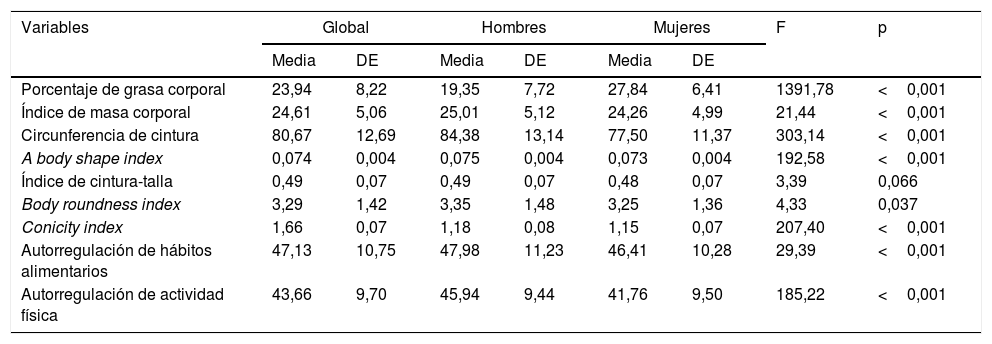Determinar el indicador antropométrico que presenta mayor fuerza de asociación con el porcentaje de grasa corporal y la autorregulación de alimentación y actividad física en jóvenes estudiantes universitarios, para su uso por personal de enfermería en atención primaria.
MétodoSe realizó un estudio transversal en 3.869 estudiantes universitarios mexicanos, de los cuales el 53,9% fueron mujeres. Se siguieron procedimientos estándar para la antropometría incluyendo peso, talla y circunferencia de cintura. Con estos datos se calcularon índice de masa corporal (IMC), A Body Shape Index, índice cintura-talla, Body roundness index y Conicity index. Se aplicaron la Escala de autorregulación de hábitos alimentarios y la Escala de autorregulación de actividad física. Se estimaron medias con desviación estándar, porcentajes y coeficientes de correlación de Pearson.
ResultadosEl grupo de hombres presentó prevalencia superior de exceso de peso en comparación con las mujeres. Se encontraron correlaciones inversas entre la mayoría de los índices antropométricos y la autorregulación de hábitos alimentarios y de actividad física. Sin embargo, en todos los casos las correlaciones fueron bajas. El porcentaje de grasa corporal tuvo una asociación media con Conicity index y fuerte con IMC, circunferencia de cintura, índice cintura-talla y Body roundness index, siendo el IMC el que presentó el coeficiente de correlación más fuerte.
ConclusionesDe los indicadores analizados, el IMC muestra la fuerza de asociación más fuerte con el porcentaje de grasa corporal en estudiantes universitarios, por lo que se sugiere mantener su uso en enfermería para la determinación de obesidad por su simplicidad de estimación.
We aim to determine the anthropometric indicator that is most strongly associated with the percentage of body fat and self-regulation of eating behaviour and physical activity among young university students.
MethodA cross-sectional study was conducted on 3,869 Mexican university students, of which 53.9% were women. Standard procedures for anthropometry were followed, including weight, height and waist circumference. This data was used for calculating Body Mass Index (BMI), A Body Shape Index, waist-to-height ratio, Body Roundness Index and Conicity index. The self-regulation of eating habits scale and the self-regulation of physical activity scale were used. Mean with standard deviation, percentages and Pearson correlation coefficient were estimated.
ResultsThe group of men shown a higher prevalence of excess weight compared to the women. Inverse correlations between most anthropometric indices and self-regulation of eating behaviour and physical activity were found. However, in all cases the correlations were weak. The percentage of fat had a medium frequency of association with Conicity index and high with BMI, waist circumference, waist-to-height ratio and Body Roundness Index, where the BMI showed the highest correlation coefficient
ConclusionsThe BMI shows the highest magnitude of association with percentage of body fat in university students among the indicators analysed. Therefore it is suggested that nurses use BMI to determine obesity because it is easy to calculate.











